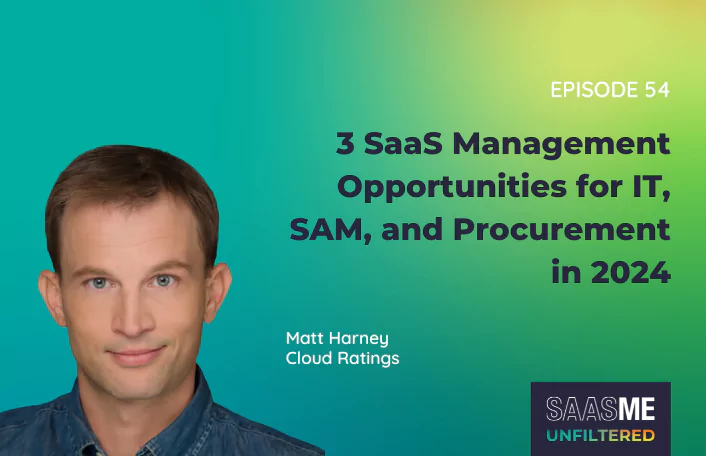03/28/2024
Table of Contents
In 2023, organizations spent an average of $45M on SaaS. Yet, $18M of that is wasted. This isn’t chump change – it’s your second largest operating expense. That’s why we’re calling 2024 the year of opportunity for software management.
Between rampant license waste, heightened security risks, and surplus of renewals, it’s hard not to feel like you’re treading water. Add in rising vendor costs and tight budgets, and you’re soon gasping for breath.
In this episode, Zylo co-founder Ben Pippenger and Cloud Ratings founder Matt Harney examine trends from the 2024 SaaS Management Index and how IT, Software Asset Management, and Procurement leaders overcome these headwinds and come out on top.
Guest Spotlight
Name: Matt Harney
What he does: Founder at Cloud Ratings
Connect with Matt online: LinkedIn | Newsletter
Episode Highlights
Cloud Optimization Is Maturing, Opening Opportunity for SaaS Optimization
“If you look at the scale of the bills and just the spend on cloud infrastructure, there’s a real material savings and it’s also very targeted. You can focus on your Amazon spend and get real dollars out of there. We’ve seen analogs to Zylo like Vantage have been growing explosively, as you’re able to get surgical and focus on specific client items in your cloud costs, and then also just do better on the blocking and tackling with your enterprise licensing agreements, your reserved instances. What we have seen though, is that the wave has passed or at least plateaued a bit, and what we’ve seen in the back half of 2023 has been that optimization trend has flat lined a bit or plateaued. Still at a much higher level than it was three years ago, the overall interest levels in cloud optimization are high, but they’ve plateaued. We’ve seen that in the earnings for Amazon, Google, Microsoft, Datadog yesterday, Hashi, even Box to a certain extent. So I think there’s some parallels.” – Matt Harney
SaaS Management Is More Complex Than Cloud Management
You compare that to SaaS management and with SaaS management, you don’t have the depth of the number of services that you’re tracking for a single app, but you have way more apps. Our catalog of apps that we discover against is about 22,000 applications. Our system’s trying to find those apps and then when we find them, we bring them in and give organizations the ability to then manage those applications and optimize them in our system but you have to remember, each of those apps are different companies for the most part. Each of those companies have different pricing models. Each of them has different ways to get the data that we need in order to look at what does usage look like, and then how do I optimize it based on the contract that I have with that company? So there’s just varying levels of complexity that you have with SaaS management that’s different from cloud management.” – Ben Pippenger
A Holistic SaaS Management Practice Helps Drive Greater Cost Savings
“The thing that jumped out at me from doing the math from your report with the per employee spend down 14%, if you go look at the net revenue retention rates of best-in-class vendors like Datadog and Monday, who have a controllable element in it, relative to certain other SaaS applications. At peak they were running at 130% NRR, and that dipped down to 112% range. That lines up perfectly with Zylo’s own per employee spend reduction. Now, the overall NRR contraction is a bit below Zylo. This quarter it’s running around 8% contraction year-over-year. The data I focused on your report was closer to 14%. Now granted, that means the Zylo customers are cutting more than the average user, and that makes sense. You have a more progressive, aggressive posture and you are ahead of the curve cutting, but that’s what we’re seeing on the vendor side and it’s a real issue. Frankly, as a business owner myself, I’ve always observed these net revenue retention rates as, it’s one thing to have a 5% 10% increase in a budget line item, but when you’re talking 20, 25%, that gets into the range of unsustainable.” – Matt Harney
Governance Is Critical, Even More So with the Emergence of AI
“The reason we looked at [Netflix’s Freedom and Responsibility deck] was it’s remained popular and we also leveraged some research from Forrester. There’s demographic changes that have occurred naturally since 2009, that millennials and Gen X are 21% more desirous of having freedom and responsibility in their day-to-day role in a company. They’re less willing to be told what to do, and that makes sense. We also looked at it through a lens of AI because this whole concept of freedom and responsibility is going to have new dimensions to it around reputation. You’ve seen in the news, lawyers citing cases that did not exist due to hallucinations, and it’s just horribly embarrassing. You can see possibilities of that in any type of business. Security risks, in terms of these small, new emerging vendors handling sensitive information or just adding new security vectors into your company.” – Matt Harney
AI Hype Underwhelming But Will Be Enduring Long-Term
I would characterize it as the demand has actually been a bit underwhelming, when you look at [AI], particularly for all of the hype. You would expect that the demand would be continuously accelerating through word of mouth, and it actually had a peak in the middle of the year and declined. Now, there’s been some upturn in things like Microsoft Copilot, but of course a lot of this is driven by product announcements and the like. But very similar to what you’ve seen at Zylo, that these AI apps really lend themselves to being individual purchases and productivity enablers. And we look at those, we call them atomic apps, like personal productivity in areas like copywriting or podcast editing, video tools, but far, far less on the compound enterprise apps that take together individual productivity tools and make a more sophisticated app that fits within an enterprise. So short term, little underwhelming on the interest trends. Long term, I’m pretty bullish on AI and the durability of the trend. If you look at the ROI like companies disclosing ROI gains, it’s around 55% gain across a broad mix of industries and functions like customer service, supply chain, data accuracy, quality assurance. When you have that type of gain and automation, it’s just so powerful and it’s going to take a while for these examples to figure themselves out. But long term, I’m excited. I think near term, if you feel like you’re behind, a lot of people are behind because this is not easy to figure out.” – Matt Harney
Top Quotes
18:20 – “ I’ve always observed these net revenue retention rates as, it’s one thing to have a 5% 10% increase in a budget line item, but when you’re talking 20, 25%, that gets into the range of unsustainable.”
28:22 – “Short term, little underwhelming on the interest trends. Long term, I’m pretty bullish on AI and the durability of the trend”
Recommended Resources
Read the reports mentioned in this episode:
Check out other episodes here or wherever you listen to podcasts.
ABOUT THE AUTHOR

Ben Pippenger
Ben Pippenger is Staff Product Manager and Co-Founder of Zylo, where he helps enterprises maximize the value of their SaaS investments. With more than 20 years of experience in B2B software, Ben is a recognized thought leader in SaaS Management, license optimization, and IT strategy. Before founding Zylo, he held product and account leadership roles at Salesforce and ExactTarget. A self-proclaimed SaaS geek, Ben regularly speaks on topics like shadow IT, SaaS ROI, and software lifecycle management.

